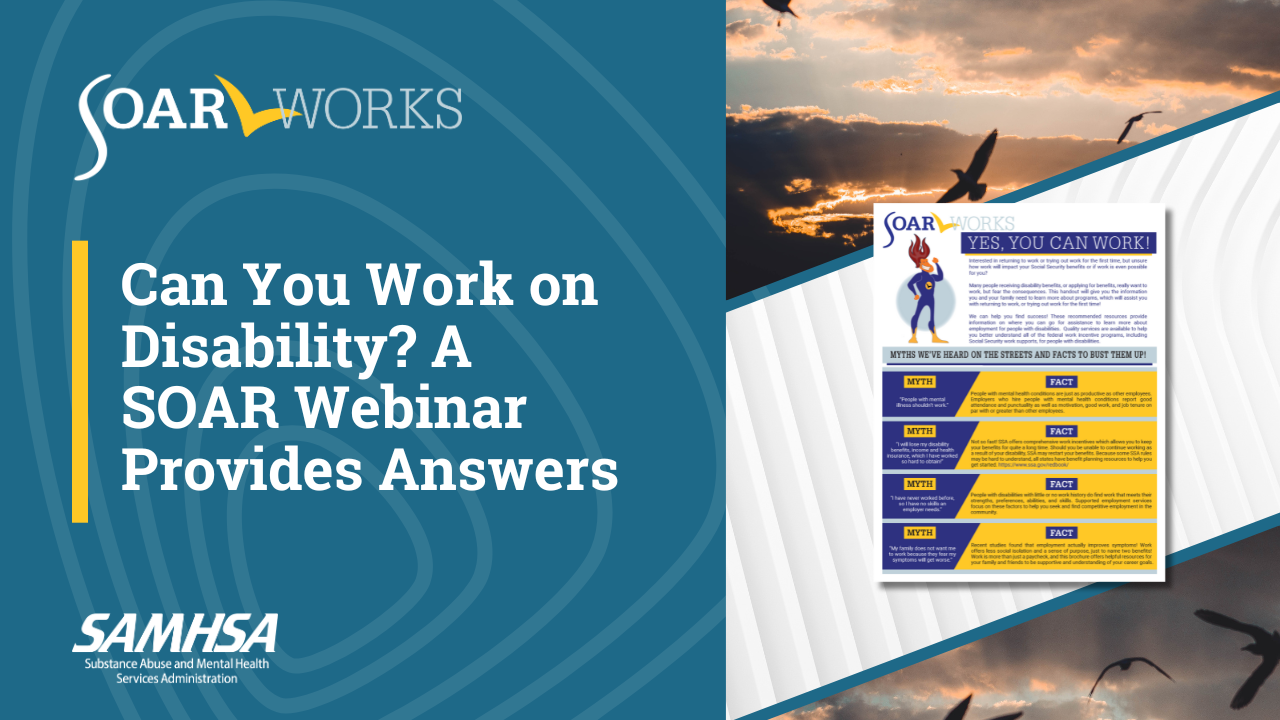Competitive employment can support the overall well-being and stability of individuals with disabilities who are applying for or receiving Supplemental Security Income (SSI) and/or Social Security Disability Insurance (SSDI) benefits. Achieving and maintaining employment can lead to more stable finances, improved mental health, and a sense of community, but many people receiving SSI/SSDI worry that working might make them lose their benefits.
The SAMHSA SOAR TA Center recently hosted a webinar titled “Yes, You Can Work! Maximizing Income Through Competitive Employment” to address this concern. The webinar featured experts from Cornell University’s Yang-Tan Institute on Employment and Disability and the National Disability Institute, along with a SOAR provider and an SSI/SSDI beneficiary who shared their experiences. Read on to learn the essential points.
Q: What are the primary benefits of working while applying for or receiving SSI/SSDI?
A: Competitive employment provides financial independence, enhances self-esteem, and improves overall quality of life. Employment can also offer social connections and a structured routine, which benefit mental health.
Q: Will you lose SSI/SSDI benefits if you work?
A: Not necessarily. Employment can affect SSI/SSDI benefits, but there are several work incentives that allow beneficiaries to work and still receive benefits. For example, the Social Security Administration (SSA) excludes some earnings and offers programs like the Trial Work Period (TWP) and Extended Period of Eligibility (EPE) to support beneficiaries in transitioning to work without losing benefits immediately. The SOAR TA Center’s “Yes, You Can Work!” page and infographic can provide additional information on working while applying for or receiving SSI or SSDI. The SOAR TA Center also has a FAQ answering common questions from case workers and applicants or beneficiaries about working while applying for or receiving benefits.
Q: What resources are available to help people receiving benefits understand and navigate work incentives?
A: Resources include SSA’s Red Book, which provides detailed information on work incentives, the SOAR TA Center’s tools and guides, and benefits planners who can offer personalized assistance. SSA’s Ticket to Work program also supports beneficiaries in finding employment.
Q: How can providers support beneficiaries in discussing competitive employment?
A: Providers can use the SOAR Employment Conversation Guide to initiate discussions about work, addressing common fears and misconceptions. It’s crucial to encourage open, honest conversations about the benefits of work and provide accurate information about how work affects benefits.
Q: What role do vocational rehabilitation programs play in supporting employment for beneficiaries?
A: Vocational rehabilitation programs offer various services, including job training, resume building, interview practice, and job placement. These programs work with beneficiaries to develop individualized plans for achieving employment goals.
Q: What’s an example of a successful employment story?
A: Neena Massey, an SSDI beneficiary, joined the webinar and shared her story of working as a Lyft driver while building her art and healing business. Her flexible work schedule and the ability to deduct business expenses as a self-employed individual have been crucial in managing her health and finances.
Q: What is the role of self-employment and gig work for individuals with disabilities?
A: Self-employment and gig work offer flexibility, allowing individuals to work according to their own schedules and capabilities. This can be particularly beneficial for those with fluctuating health conditions. Additionally, it provides an opportunity to pursue personal interests and passions.
Q: How can providers address beneficiaries’ fears about losing benefits if they start working?
A: Providers can alleviate fears by educating beneficiaries about work incentives and safety nets like Expedited Reinstatement, which allows benefits to be quickly reinstated if work is unsuccessful. Emphasizing that income from work often outweighs the loss of benefits can also help.
Q: What tools are available to help beneficiaries plan their employment journey?
A: Tools such as the SOAR Employment Conversation Guide and benefits calculators are practical resources for planning and understanding the impact of employment on benefits.
Q: How can collaborative efforts enhance employment outcomes for beneficiaries?
A: Collaboration between SOAR providers, vocational rehabilitation programs, employment networks, and benefits planners ensures that beneficiaries receive comprehensive support. This team approach addresses various aspects of employment, from job readiness to benefits planning.
For more in-depth insights and practical strategies, watch the full webinar below.
This blog post was developed with the assistance of generative artificial intelligence.


